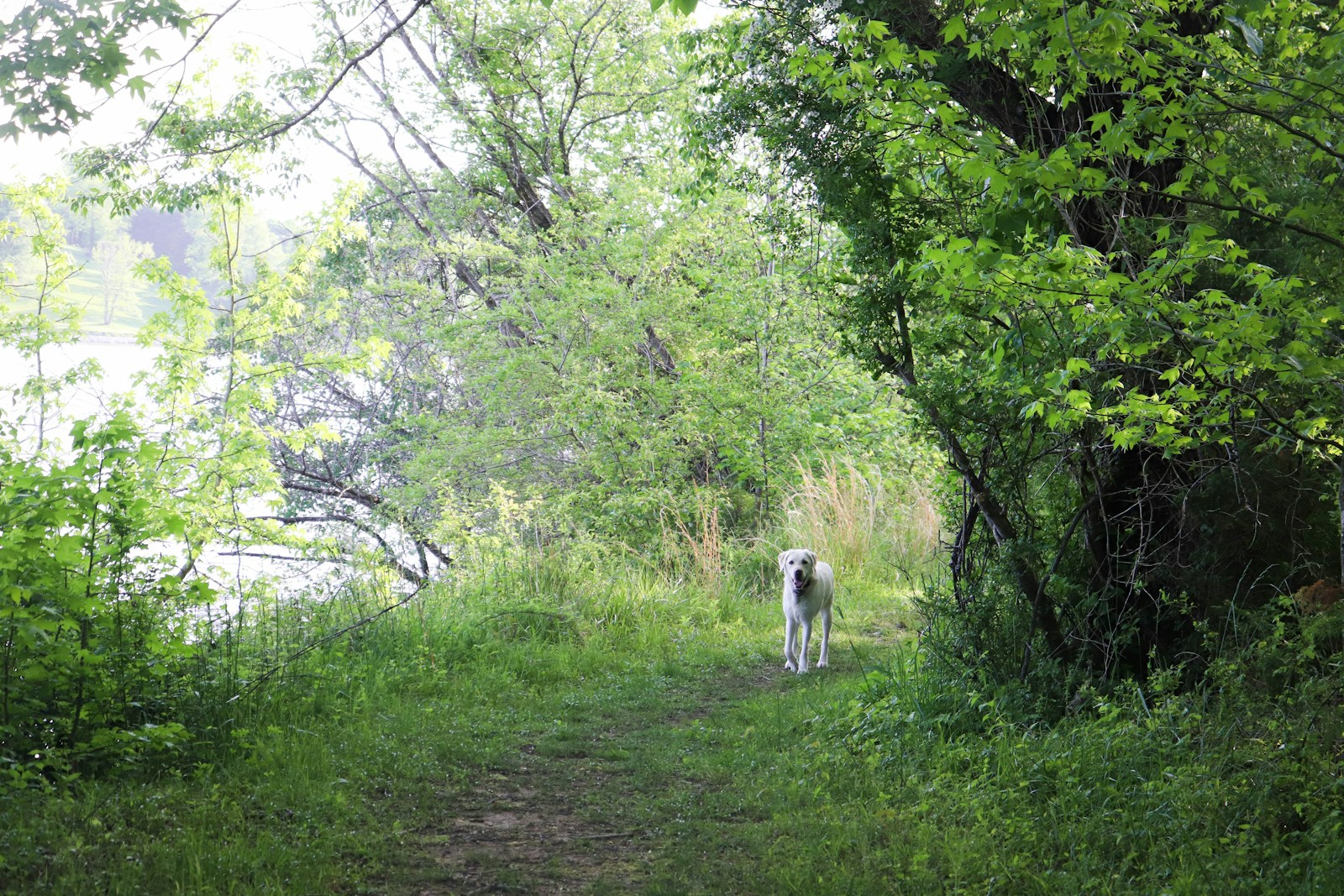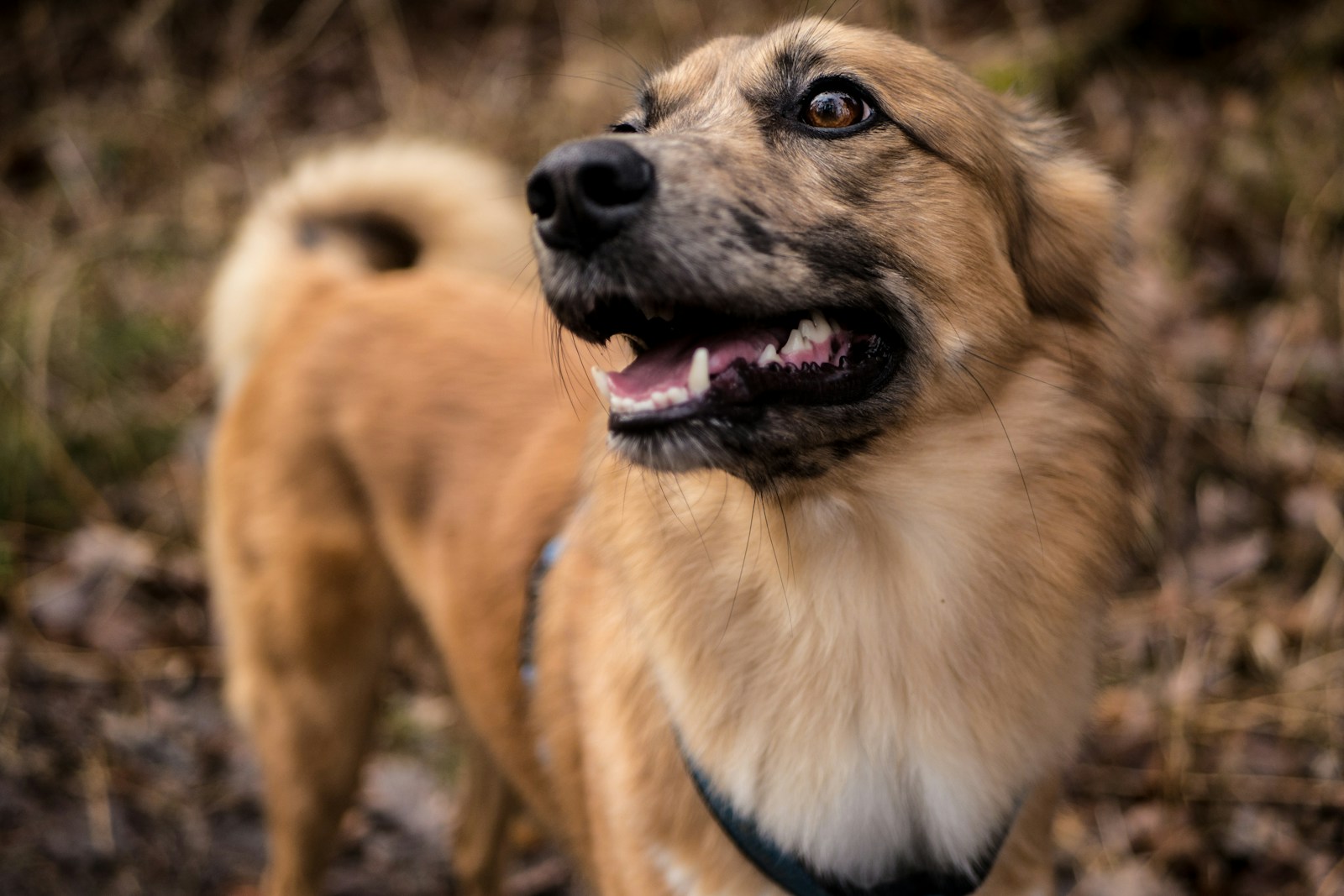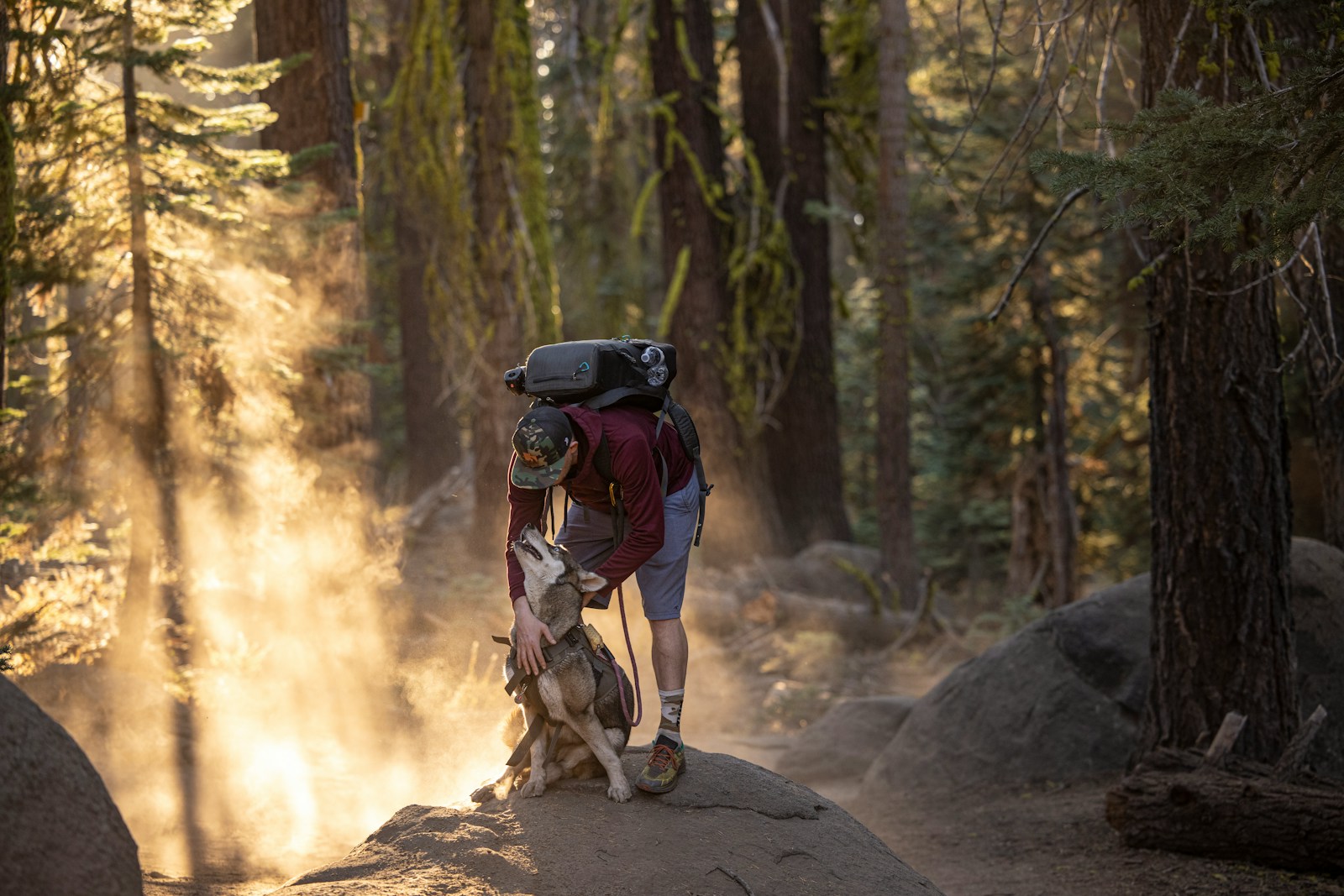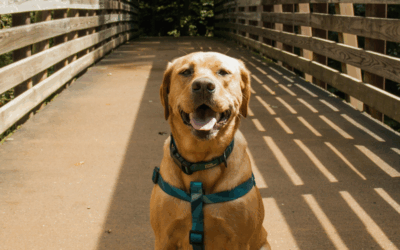When I first started leading dogs through the forests and river trails nearly two decades ago, I had no idea those early morning adventures would become the foundation of everything we do at Canine Cardio. What began as simple walks evolved into something much deeper—structured exploration that transforms both dogs and their humans.
Those quiet hours on the trail taught me that hiking isn’t just about burning energy. It’s about building calm confidence, strengthening focus, and creating the kind of balanced relationship that makes every other aspect of training possible. When a dog learns to follow your lead through challenging terrain, navigate new sights and sounds with composure, and maintain attention despite countless distractions, they’re developing skills that translate directly to everyday life.
This guide shares our favorite dog friendly trails near Arlington, VA—spots where we’ve witnessed countless transformations and discovered that the best training often happens when you’re not trying to train at all.

Photo by Laura Roberts on Unsplash
The Value of Exploring Nature Together
Nature has a way of naturally decompressing both dogs and humans that no indoor environment can replicate. The varied terrain challenges coordination and builds stamina while new scents, sounds, and sights provide the kind of mental enrichment that indoor facilities simply can’t match. Unlike the chaos of many dog parks, where excitement escalates unchecked, structured hiking offers controlled exposure to stimulation.
The magic happens in those moments when a dog who typically pulls on leash learns to navigate a narrow trail beside their handler, or when an anxious pup discovers they can handle the sound of rushing water without shutting down. I’ve watched reactive dogs transform into calm, focused companions simply through consistent exposure to nature under clear leadership.
On-leash hiking provides safety and control that off-leash adventures can’t guarantee. Your dog learns to work with you rather than despite you, building the kind of partnership that makes every future training session more effective. The trail becomes a natural classroom where impulse control, focus, and confidence develop organically through experience rather than drill.
What Makes a Trail “Canine Cardio Approved”
Not every dog friendly trail makes the cut for our structured pack hikes. We look for specific qualities that support our mission of building balanced, confident dogs rather than simply exhausting them.
First, we prioritize moderate terrain with safe footing and manageable elevation changes. Trails that challenge without overwhelming allow dogs to build confidence gradually while developing physical strength and coordination. Rocky scrambles might look impressive, but they often create stress rather than success.
Shade and water access are non-negotiable, especially during Virginia’s humid summers. Dogs need regular opportunities to cool down and hydrate, and shaded paths prevent overheating that can quickly turn a positive experience negative.
Clear leash requirements protect everyone on the trail. Parks that enforce on-leash policies create predictable environments where dogs can focus on their handlers rather than worrying about unexpected interactions with unfamiliar dogs.
We also seek lower traffic during weekday mornings when possible. Fewer hikers mean more opportunities for training moments without overwhelming stimulation. Early morning also offers cooler temperatures and calmer energy that supports focused work.
Before heading out, we always check visitor center information or park websites for current trail conditions, seasonal restrictions, and any temporary closures. Bringing plenty of water for both dogs and humans is essential, along with a long-line leash for controlled exploration when appropriate.

Photo by Kai Wenzel on Unsplash
Best Places Near Arlington, VA, For A Dog-Friendly Hike
Potomac Overlook Regional Park
This hidden gem offers short, scenic loops with stunning river overlooks that never get old. The moderate terrain and well-maintained paths make it perfect for structured “follow the leader” walks where dogs learn to match their handler’s pace and direction rather than pulling ahead.
Early weekday mornings provide the peaceful atmosphere we love for focused training. The overlook points create natural stopping places for impulse control practice—teaching dogs to settle and observe rather than constantly moving forward.
Pro tip: Use the directional changes when passing other hikers as opportunities to reinforce attention and recall. A simple direction change can redirect a dog’s focus back to you rather than fixating on approaching people or dogs.
Theodore Roosevelt Island
This remains one of our favorite dog friendly hikes for combining balanced energy with natural beauty. The island’s unique combination of boardwalk sections and wooded scenic trails provides varied surfaces that build confidence and improve footing awareness.
The boardwalks offer excellent opportunities for teaching dogs to navigate different textures and sounds—skills that translate to urban environments. The wooded sections provide natural decompression zones where dogs can practice calm alertness without overstimulation.
Fall visits offer gorgeous views with fewer crowds, creating ideal conditions for structured group work. The island’s loop format allows for sustained cardio while maintaining clear start and end points that dogs learn to recognize.
Turkey Run Park
For dogs ready to level up their stamina and focus, Turkey Run delivers moderate to steep hiking trails with stunning views of the Potomac River. The elevation changes provide natural conditioning while the varied terrain keeps dogs mentally engaged.
The park’s extensive shade makes it excellent for summer training when other locations become too hot for safe exercise. Multiple trail options allow us to customize difficulty based on each dog’s fitness level and confidence.
This location excels for practicing leash control on challenging terrain. Dogs learn to trust their handler’s guidance when footing becomes uncertain, building the kind of partnership that extends far beyond the trail.
Scott’s Run Nature Preserve
Scott’s Run features waterfalls, creek crossings, and moderate climbs that adventurous dogs absolutely love. The water features provide natural cooling opportunities and teach dogs to navigate wet, slippery surfaces with confidence rather than fear.
This hidden gem is ideal for dogs who enjoy exploration but can maintain control around exciting stimuli. The creek crossings offer perfect opportunities for building trust—many dogs initially hesitate at water obstacles but learn to follow their handler’s confident lead.
Fair warning: bring extra towels. Most dogs can’t resist at least some splashing, and we’ve learned to embrace the muddy paws as part of the adventure. The joy on their faces makes the extra cleanup worthwhile.
Difficult Run Trail & Great Falls Park Connector
About an hour from Arlington, this trail system offers some of the best dog friendly hikes in the region for sustained cardio and advanced obedience practice. The long loops provide space for extended training sessions while the scenic beauty keeps both dogs and handlers motivated.
The connector trails allow for customized distances based on your dog’s fitness level. Beginners can stick to shorter segments while conditioned dogs can tackle longer adventures. The gorgeous photo opportunities don’t hurt either—though we always prioritize training over Instagram moments.
This location excels for structured group work when we have multiple dogs at similar skill levels. The wide paths and varied terrain provide natural separation opportunities while maintaining pack cohesion.
Structure Over Chaos: Making the Most of Every Adventure
What separates our hiking approach from casual walks is the intentional structure we maintain from start to finish. Clear start and stop cues help dogs understand when they’re “working” versus simply existing. Pack order matters—dogs learn their position and maintain it rather than jockeying for the lead position.
Structured decompression breaks prevent overstimulation while reinforcing impulse control. Rather than allowing excitement to build unchecked, we create moments of calm observation that help dogs process their environment without becoming overwhelmed.
Safety and leadership go hand in hand. Calm, confident guidance from handlers prevents the kind of reactive responses that turn positive experiences negative. Dogs learn to look to their humans for direction rather than making independent decisions that might compromise their safety or the safety of others.
We encourage all our clients to “train for reality™”—using outdoor environments as learning spaces rather than free-for-alls. Every trail offers countless opportunities to practice real-world skills in a natural setting where dogs are naturally more receptive to guidance.
Our Pro Tips
Always bring plenty of water for both you and your dog, along with a collapsible bowl for easy drinking. Summer heat requires additional cooling gear like wet bandanas or cooling vests, while winter conditions might call for paw protection depending on trail conditions.
Leash control prevents overstimulation and injury while maintaining the structured environment that supports learning. A six-foot leash provides enough freedom for natural movement while keeping your dog close enough for immediate guidance when needed.
Weekday mornings offer the best conditions for focused training with fewer crowds and cooler temperatures. Weekend trails can become overwhelming with high traffic, making it difficult to maintain the calm energy we seek.
Know your dog’s limits in terms of age, stamina, and confidence level. Pushing beyond appropriate boundaries creates negative associations that can set back training progress. Build gradually rather than attempting impressive distances before your dog is ready.
End every hike with a cooldown period and calm decompression rather than simply loading into the car when you reach the trailhead. This transition time helps dogs process their experience and return to baseline energy levels.
Where Wellness Meets the Wild: Our Mission in Motion At Dog Friendly Trails
These trail adventures represent everything we believe about canine wellness at Canine Cardio. Movement with purpose, structure that builds confidence, and leadership that creates trust—all happening in the most natural classroom available.
Watching dogs transform through structured outdoor experiences reinforces why we do this work. When a dog who once pulled frantically on a leash, learns to walk calmly beside their handler on a challenging trail, or when an anxious pup discovers they can navigate new environments with confidence, we see our mission in action.
These adventures support our greater goal of helping dogs live longer, healthier, and more balanced lives. The physical conditioning builds strength and stamina, the mental challenges develop problem-solving skills, and the partnership moments strengthen the human-animal bond in ways that no indoor facility can replicate.
Whether you’re ready to join one of our structured pack hikes or simply want to explore these trails with your own dog, remember that every step is an opportunity for growth. After your adventure, consider stopping by Snouts & Stouts, our on-leash café, where you can continue the calm socialization in a controlled environment.
Dog owners, the trails are calling, and your dog is ready for the adventure. The question isn’t whether they can handle it—it’s whether you’re ready to discover what’s possible when structure meets the wild.




